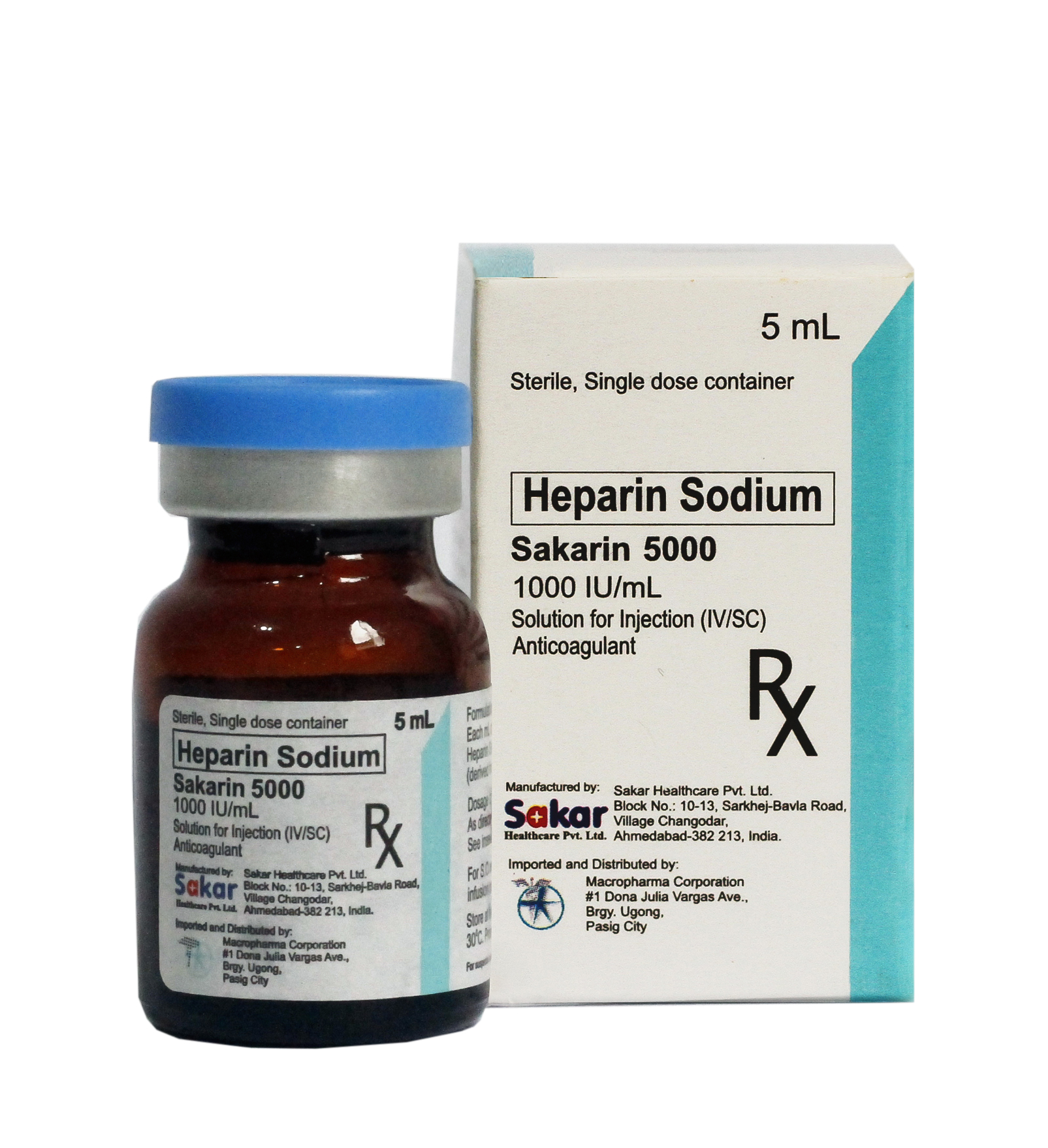
INDICATION: Prophylaxis & treatment of venous thrombosis & its extensions, pulmonary embolism & peripheral arterial embolism. Atrial fibrillation w/ embolization. Diagnosis & treatment of acute & chronic consumptive coagulopathies (disseminated intravascular coagulation). Prevention of clotting in arterial & cardiac surgery; cerebral thrombosis in evolving stroke. Adjunct treatment of coronary occlusion w/ acute MI. Anticoagulant in blood transfusions, extracorporeal circulation, dialysis procedures & in blood samples for laboratory practices.
DOSAGE: Deep SC Initially 5,000 u followed by 10,000 u. Adult weighing 68 kg Deep SC initially, 5,000 u followed by 10,000 u. Intermittent IV inj Initially 10,000 u undiluted or in 50-100 mL isotonic NaCl inj or 5,000-10,000 u undiluted or in 50-100 mL isotonic NaCl inj every 4-6 hr or 8,000-10,000 u of conc soln every 8 hr or 15,000-20,000 u of conc soln every 12 hr. Surgery of the heart & blood vessels Initially not <150 u/kg. Frequently, 300 u/kg to last <60 min or 400 u/kg to last longer than 60 min. Low dose prophylaxis of post-op thromboembolism 5,000 u 2 hr before surgery followed by 5,000 u for every 8-12 hr for 7 days or until the patient if fully ambulatory. Childn IV inj 50 u/kg followed by 100 u/kg every 4 hr to clotting time.
OVERDOSAGE:Symptoms: Nosebleeds, blood in urine or tarry stools.
CONTRAINDICATION: It is contraindicated in patients with known hypersensitivity to Heparin.
WARNING: Heparin is not intended for intra muscular use. Hypersensitivity: Patients with documented hypersensitivity with heparin should be given the drug only in clearly life-threatening situations. Haemorrhage: Heparin sodium should be used with extreme caution in diseased states in which there is increase danger of haemorrhage. Some of the conditions in which increased danger of haemorrhage exists are a) Cardiovascular: Subacute bacterial endocarditis, arterial sclerosis, increased capillary permeability, during and immediately following major surgery, especially involving brain, spinal cord or eye. b) Haematologic: Conditions associated with increased bleeding tendencies, such as haemophilia, thrombocytopenia and some vascular purpuras. c) Gastrointestinal: Ulcerative lesions and continuous tube drainage of the stomach or the small intestine. d) Other: Menstruation, liver disease with impaired hemostasis.
SPECIAL PRECAUTION: Heparin therapy should be carefully monitored and adjusted to the patients coagulation test results. This will reduce the risk of over dosage and consequent haemorrhage. It is also important as a pre emptory signal to the development of severe adverse effects such as thrombocytopenia. Allergic conditions: as heparin is derived from animal tissues it should be used with caution in patients with a history of allergy as hypersensitivity reaction may occur. Heparin Resistance: Increased resistance to heparin is frequently encountered in fever, thrombosis, thrombophlebitis, infections with thrombosis tendencies, myocardial infarction, cancer and in post surgical patients. Increased risk in older women: A higher incidence of bleeding has been reported in women over 60 years of age.
Use in pregnancy: The use of heparin in pregnancy as an alternative to warfarin is not without hazard. Although heparin doesn't cause malformations, an increased incidence of human foetal loss and prematurity associated with haemorrhage has been reported. Heparin doesn't cross the placental barrier.
Use in lactation: Heparin is not secreted in the breast milk.
ADVERSE REACTION: Haemorrhage is the major risk associated with Heparin therapy. Heparin in therapeutic and prophylactic doses is essentially non-toxic but may cause allergic reactions and possibly anaphylactic reactions in susceptible patients. Delayed onset thrombocytopenia has also been reported. If this occurs, drug withdrawal is required.
Skin necrosis at the injection site has been reported and is thought to be a local manifestation of heparin induced platelet aggregation and thrombosis. This should be taken as a warning in patients who develop it and heparin therapy should be immediately discontinued.
DRUG INTERACTION: The administration of local anaesthetic solutions containing adrenaline to patients receiving monoamine oxidase inhibitors or tricyclic anti depressants may produce severe, prolonged hypertension. Concurrent use of these agents should generally be avoided. In situations in which concurrent therapy is necessary, careful patient monitoring is essential. Concurrent administration of vasopressor drugs and of ergot-type oxytocic drugs may cause severe, persistent hypertension or cerebrovascular accidents.
STORAGES: tore at temperatures not exceeding 25°C. Protect from light. Do not freeze.
PRESENTATION/ PACKING: Soln for inj (vial) 1,000 IU/mL x 5 mL. 5,000 IU/mL x 5 mL.

